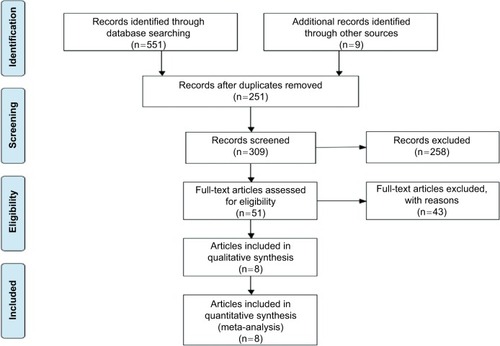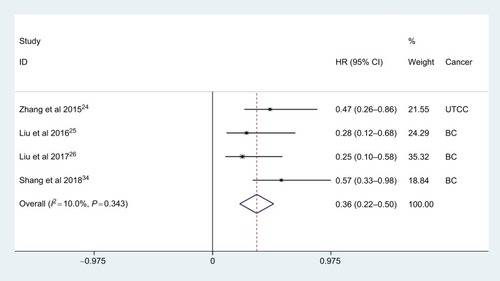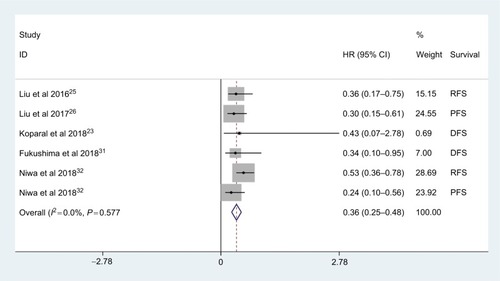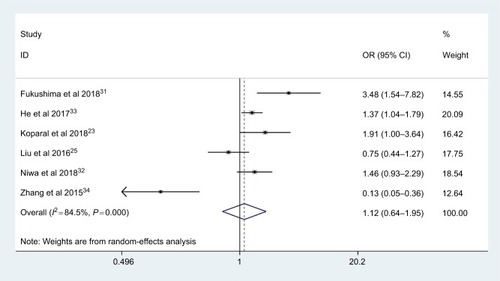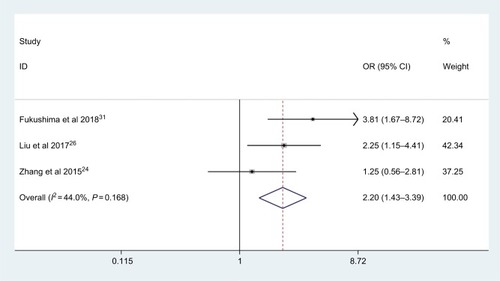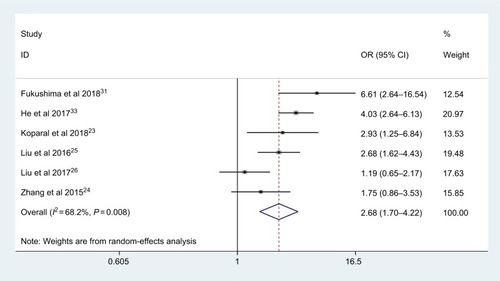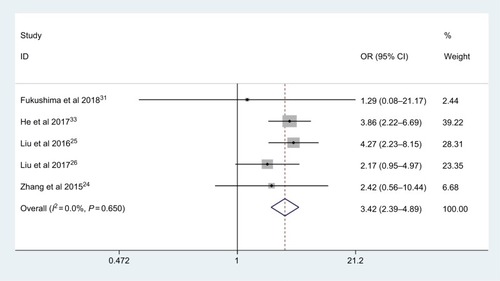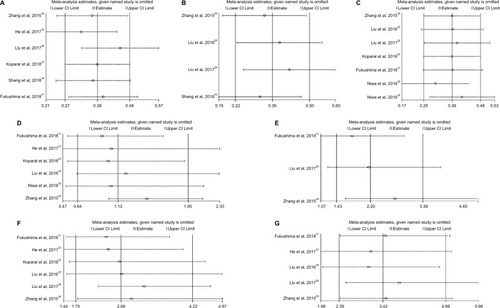Abstract
Background
Emerging studies reported that preoperative albumin-to-globulin ratio (AGR) correlated with tumor progression and prognosis in several types of cancer. The aim of this study was to systematically explore the association between preoperative AGR and clinical outcomes in cancers of the urinary system.
Methods
Relevant articles were searched in PubMed, Embase and Web of Science by two independent investigators from inception to June 1, 2018. Eligible studies were selected based on predetermined selection criteria. Summarized HRs or ORs and 95% CIs were calculated for prognosis and clinicopathologic features with the fixed-effects or random-effects models.
Results
Eight cohort studies comprising 2,668 patients were included for analysis. The pooled results showed that a low AGR significantly correlated with poor OS (HR: 0.38, 95% CI: 0.27–0.48, P<0.001), worse cancer-specific survival (CSS) (HR: 0.36, 95% CI: 0.22–0.50, P<0.001) and inferior event-free survival (EFS) (HR: 0.36, 95% CI: 0.25–0.48, P<0.001) in urologic cancers. In addition, patients in low and high AGR groups showed significant differences in lymphovascular invasion (P<0.001), pT status (P<0.001) and pN status (P<0.001).
Conclusion
Preoperative AGR might be a valuable, cheap and reproducible prognostic bio-marker in urologic cancers following surgical resection.
Introduction
Albumin (ALB) and globulin (GLB) are two major abundant proteins in human serum. Increasing evidence has shown that albumin levels reflect nutritional status and also correlate with systemic inflammatory response.Citation1–Citation3 Furthermore, albumin could be used as a useful prognostic marker in cancers, such as ovarian cancer, gastric cancer, lung cancer and colorectal cancer.Citation4–Citation7 On the other hand, globulin, another major component of serum protein, has been reported to be involved in a series of immune and chronic inflammation responses,Citation8–Citation11 and might serve as a predictor of tumor progression and survival.Citation12–Citation15
However, the levels of albumin and globulin in serum could be easily influenced by other confounding factors, and this could affect the efficiency and accuracy in prognosis detection. To overcome the deficiency, a novel prognostic index, the albumin-to-globulin ratio (AGR), was identified and reported.Citation16,Citation17 AGR is a combination of serum albumin and globulin. It has been suggested that the AGR might be a more stable and reliable indicator than serum albumin or globulin alone in prognostication.Citation18,Citation19 It has been demonstrated to be a valuable and promising prognostic tumor marker in various types of cancers.Citation18–Citation22
Recently, several studies have reported the relationship between AGR and prognosis in urologic cancers, such as bladder cancer, renal cell carcinoma and upper tract urothelial carcinoma.Citation23–Citation26 However, reports on the prognostic effect of AGR in urologic cancers are inconsistent and debatable, and most studies published to date also have been restricted with small samples. Therefore, in order to provide clear evidence in favor of the prognostic significance of the AGR, it is necessary to conduct a meta-analysis to synthetically investigate the association between the AGR and clinical outcomes in patients with urinary system cancer.
Methods
Literature retrieval and study selection
A systematic literature search was performed in PubMed, Embase and Web of Science for eligible studies assessing the prognostic significances of the AGR in cancers of the urinary system until June 1, 2018. The search strategy combined the following terms: “albumin/globulin,” “albumin to globulin,” “albumin and globulin,” “albumin to globulin ratio,” or “AGR,” and “bladder,” “kidney,” “prostate,” “testicular,” “renal,” or “urothelial,” and “cancer,” “carcinoma,” “adenocarcinoma,” “tumor,” or “malignancy.”
Inclusion and exclusion criteria
Studies were identified eligible and included if they met the following inclusion criteria:
All patients enrolled were histologically confirmed to be primary urologic cancers;
The study reported the association between the preoperative albumin-to-globulin ratio (AGR) and OS/CSS/DFS/ PFS/RFS;
Cases were divided into two groups according to the cutoff value of AGR;
Full-text studies were published in English.
The exclusion criteria were as follows:
Nonoriginal studies, such as letters, reviews, meta-analysis, poster session or abstracts;
Studies on cancers that not derived from urinary system;
Insufficient data for calculating the HR and 95% CI.
Data extraction and quality assessment
The following data were extracted by two independent researchers: the surname of the first author, publication year, country of research, cancer type, included period, number of cases, study type, number of male and female, age distribution, survival type, cutoff value of AGR, cutoff selection, treatment method, follow-up time, overall survival (OS), CSS, disease-free survival (DFS), progression-free survival (PFS) and recurrence-free survival (RFS). The HRs and the 95% CI for cancer survival were extracted from the multivariate analysis, since they balanced many confounding factors. Additionally, the number of the patients for the clinicopathologic characteristics (tumor grade, lymphovascular invasion, pT status, pN status, pM status and pTNM stage) was extracted from the eligible studies. The Newcastle–Ottawa Scale (NOS) was utilized to assess the quality of the included studies.Citation27,Citation28 The scores according to NOS varied from 0 to 9. A score of 6 or more was identified as high quality.
Statistical analysis
Pooled HRs or ORs and their 95% CIs for cancer prognosis and clinical relevance were evaluated by Stata version 12.0 (Stata Corporation, College Station, TX, USA). DFS/PFS/ RFS values were merged into one survival outcome described as EFS.Citation29,Citation30 The heterogeneity among studies was tested by Cochran’s Q and Higgins I2 statistics; in the presence of significant heterogeneity (Phet <0.1 and/or I2 >50%), the random-effect model was employed; otherwise, the fixed-effect model was applied. Publication bias was evaluated by Begg’s test and funnel plot analysis. The sensitivity analysis was carried out by sequentially omitting individual studies to assess the robustness of the pooled results. A two-sided P<0.05 was considered statistically significant.
Results
The detailed process of study selection is shown in . According to the inclusion and exclusion criteria, eight full-texts were considered eligible and included in the meta-analysis, with a total of 2,668 cases.Citation23–Citation26,Citation31–Citation34 In these eight articles, three different kinds of urinary system cancers were included as follows: renal cell carcinoma (RCC, two articles), upper urinary tract urothelial carcinoma (UTUC, two articles) and bladder cancer (BC, four articles). All the included studies were prospective cohort trials. These studies were all published in English and released in the year of 2015 (one study), 2016 (one study), 2017 (two studies) and 2018 (four studies). These studies were carried out in three countries, namely, Turkey (one study), Japan (one study), P. R. China (six studies). All cases in the eligible studies were classified into two groups (low and high AGR groups), and the clinicopathologic characteristics of the patient data are shown in . Among these studies, six studies reported the association between AGR and OS, four studies reported the relationship between AGR and cancer-specific survival (CSS), and two studies for PFS, RFS, DFS, respectively. The main characteristics of all included studies are presented in .
Table 1 Main characteristics of eligible studies in the meta-analysis
AGR and prognosis
Overall survival
A total of six studies involving 2008 patients reported the effect of AGR on OS in urologic cancer. The pooled results showed that low AGR was significantly related with poor OS (HR: 0.38, 95% CI: 0.27–0.48, P<0.001) with no significant heterogeneity (I2=41.2%, Phet =0.132; ).
Figure 2 Meta-analysis of the relationship between AGR and OS.
Abbreviations: AGR, albumin-to-globulin ratio; BC, bladder carcinoma; OS, overall survival; RCC, renal cell carcinoma; UTCC, upper tract urothelial carcinoma.
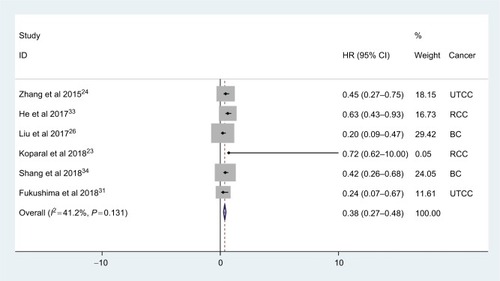
As shown in , when stratified by the cancer type, low AGR had significantly worse OS in UTCC (HR: 0.37, 95% CI: 0.18–0.56, P<0.001), RCC (HR: 0.63, 95% CI: 0.38–0.88, P<0.001) and BC (HR: 0.30, 95% CI: 0.16–0.44, P<0.001). In addition, the significant differences were also consistently observed in subgroup meta-analysis stratified by the sample size and cutoff value ().
Table 2 Subgroup analysis of the association between AGR and OS
Cancer-specific survival
Four studies with 1,142 cases reported data on the relationship between AGR and CSS in urologic cancer. The meta-analysis suggested that low AGR significantly correlated with worse CSS (HR: 0.36, 95% CI: 0.22–0.50, P<0.001), with no significant heterogeneity across studies (I2=10.0%, Phet =0.343; ). Notably, the negative effect of high AGR on CSS was also observed in patients with bladder carcinoma (HR: 0.33, 95% CI: 0.18–0.49, P<0.001).
Event-free survival
Six studies reported the association between AGR and EFS in urologic cancer; there were two studies focusing on PFS, DFS and RFS. As shown in , the pooled results indicated that the patients with low AGR had an inferior EFS in urologic cancer (HR: 0.36, 95% CI: 0.25–0.48, P<0.001) with no obvious heterogeneity among studies (I2=0.0%, Phet =0.577). And significant associations were also found between AGR and RFS (HR: 0.47, 95% CI: 0.30–0.64, P<0.001), PFS (HR: 0.27, 95% CI: 0.11–0.43, P<0.001) and DFS (HR: 0.35, 95% CI: 0.06–0.75, P<0.001).
AGR and clinicopathologic characteristics
Tumor grade
A total of six studies with 2,009 patients reported the relationship between AGR and tumor grade. As an obvious heterogeneity existed among studies (I2=84.5%, Phet =0.000), the random-effect model was used. The pooled results indicated that there was no significant association between AGR and tumor grade (OR: 1.12, 95% CI: 0.64–1.95, P=0.69; )
Lymphovascular invasion (LVI)
Only three studies with 481 patients explored the correlation between AGR and lymphovascular invasion. As shown in , no significant heterogeneity was observed (I2=44.0%, Phet =0.168), and the patients with low AGR were more likely to have lymphovascular invasion (OR: 2.20, 95% CI: 1.43–3.39, P<0.001)
pT status
Six articles with 1,834 cases coved the effect of low AGR on pT status. The random-effects model was employed (I2=68.2%, Phet =0.008); the combined results indicated that low AGR was significantly associated with deeper depth of tumor invasion (OR: 2.68, 95% CI: 1.70–4.22, P<0.001; ).
pN status
Five studies, consisting of 1,672 patients, explored the association between AGR and pN status. Analysis revealed the pooled OR of 3.42 with 95 % CI: 2.39–4.89 (P<0.001) () with no obvious heterogeneity (I2=0.0%, Phet =0.650). The pooled results showed that patients with low AGR were at significantly greater risk of lymph node metastasis.
pM status and pTNM stage
Only one study by He et alCitation32 reported the associations of AGR with clinicopathologic features of the pM status and pTNM stage in RCC patients. Patients in low and high AGR groups showed significant differences in pM-stage (P<0.001) and pTNM stage (P<0.001).
Publication bias
Funnel plot and Begg’s test were utilized to assess the publication bias. The result of Begg’s test confirmed that there was no evidence of significant publication bias among studies (POS =0.707; PCSS =0.308; PEFS =1.000; Ptumor grade = 1.000; PLVI =1.000; PpT = 1.000; PpN = 0.462; ).
Sensitivity analysis
Sensitivity analysis was performed to determine whether the pooled data would be affected by any individual cohorts, and the answers were negative ().
Discussion
Recently, a series of scores/ratios based on hematological parameters have been reported, such as modified Glasgow prognostic score (mGPS) and C-reactive protein (CRP) and albumin ratio; they were found to be potential prognostic markers in various human cancers.Citation35–Citation38 Additionally, some other important systemic inflammatory (SIR) markers, including neutrophil-to-lymphocyte ratio (NLR), neutrophil-platelet score and lymphocyte-to-monocyte ratio were reported; their prognostic values have also been widely evaluated in multiple malignancies, including gastric cancer, Ewing sarcoma and urologic tumors.Citation39–Citation41
To the best of our knowledge, as yet, no meta-analyses have been performed to assess the prognostic and clinicopathologic relevance of the AGR in cancers of the urinary system. In this meta-analysis, a total of eight studies comprising 2,668 patients were included to explore the association between AGR and the prognosis of patients with urologic cancers. The pooled results indicated that a low pretreatment AGR was significantly associated with worse clinical outcomes in urologic cancers.
Albumin accounts for the largest proportion of serum albumin in the human body. It is synthesized by hepatocytes and could be used as one of the evaluation indexes of liver function and to assess subjects’ nutritional status.Citation42–Citation44 Besides, it plays multiple crucial roles in physiological activities, such as maintaining intravascular permeability stress and as a free radical scavenger.Citation45,Citation46 Many previous studies also investigated the association between ALB and cancer. Serum albumin levels in cancer patients were significantly lower than in those without cancer,Citation46,Citation47 and low albumin levels often mean poor nutritional status, and imply weakened several immune defense systems. Furthermore, albumin was considered as an important inflammatory response marker,Citation48 low albumin level was related to enhanced inflammatory response to the tumor and increased cytokine release, including interleukin(IL)–6 and tumor necrosis factor(TNF)-α, all of these might be surrogates for more aggressive tumor behaviors.Citation49,Citation50 On the other hand, albumin has shown related antitumor and antioxidant effects; it could stabilize cell growth and DNA replication and inhibit the proliferation and growth of tumor cells.Citation51–Citation53 Low albumin levels could also decrease the response to treatment in cancer patients,Citation54,Citation55 and its clinical role as an unfavorable prognostic biomarker was also reported in various human malignancies.Citation56,Citation57
Referring to the nonalbumin proteins, they are also named as globulin (total protein – albumin). It comprises many different proinflammatory proteins, such as CRP, complement components, interleukins, immunoglobulins and so on. Prior studies had reported that inflammatory proteins were associated with tumor prognosis and progression, and displayed the predictive significance in different human cancers. For example, patients with elevated preoperative CRP had a poor survival in UTUC,Citation58–Citation60 and high complement 3 levels were shown to be related to poor prognosis in patients with colorectal cancer,Citation61 and an increased preoperative gamma globulin levels predicted poor survival in lung cancer.Citation62 In addition, the globulins were shown to be closely related with chronic inflammation. Some serum globulins, such as IL-6, IL-8, TNF-α, VEGF, they were all inflammation-related factors, and played important roles in the tumor occurrence and progression. These inflammatory factors could promote the proliferation, invasion, metastasis of tumor cell, as well as subvert the host immune response, and contribute to the tumor drug resistance.Citation63,Citation64 Overall, albumins and globulins are related with nutrition status, immunoinflammatory reactions in the human body as well as the tumor progression and development. And the AGR takes both the ALB and GLB levels into account, it may more precisely and comprehensively reflect the body’s nutritional and inflammatory states. It could be a significant prognostic biomarker that helpful to predict the clinical outcomes in cancers.
As far as we know, our study is the first meta-analysis to evaluate the prognostic significance of the AGR in patients with urologic cancers. We found that a low pretreatment AGR was closely related to worse clinical outcomes in cancers of the urinary system. A low pretreatment AGR was significantly related to shorter OS, worse CSS and inferior EFS in urologic cancers. And there were significant differences in the lymphovascular invasion, pT status and pN status among low and high AGR groups.
However, several limitations in the present meta-analysis should be taken into consideration. First, all included studies were designed retrospectively, and the number of total sample size included was relatively small. Second, studies enrolled were all involved in Asian ethnicity groups; this might limit the generalization of our conclusions; the prognostic value of AGR in more populations are needed for further confirmation. Third, the cutoff values for low AGR were different in those studies with a slight range from 1.24 to 1.68, a unified cutoff value is necessary before it could be really applied in clinical practices. The heterogeneity observed may be the inclusion of a small number of studies covering three different types of urologic tumor, each with their own particular morphologic, pathologic and clinical characteristics. Fourth, negative results were usually harder to be published than positive results, this might lead to some data missing, the number of studies exploring the relationship between AGR and some clinical features was small or none. Finally, some other factors, such as age, treatment strategy or clinical stages, also could affect the patient survival, and medication used and accompanied diseases of the patients could also influence the level of albumin and globulin.
In conclusion, our meta-analysis synthetically established a connection between pretreatment AGR and patients with urinary system cancers. A low AGR was significantly related to worse long-term survival and advanced clinicopathologic features. AGR would serve as a valuable and noninvasive prognostic marker in urologic cancers. Nevertheless, larger and prospective multicenter research trials should be conducted to validate the clinical application of pretreatment AGR in urologic cancers.
Supplementary material
Table S1 Relevant data for AGR and clinicopathologic features
References
- FukushimaHKobayashiMKawanoKMorimotoSPrognostic value of albumin/globulin ratio in patients with upper tract urothelial carcinoma patients treated with radical nephroureterectomyAnticancer Res20183842329233429599356
- HeXGuoSChenDPreoperative albumin to globulin ratio (AGR) as prognostic factor in renal cell carcinomaJ Cancer20178225826528243330
- KoparalMYPolatFÇetinSBulutECSözenTSPrognostic role of preoperative albumin to globulin ratio in predicting survival of clear cell renal cell carcinomaInt Braz J Urol201844
- LiuJDaiYZhouFThe prognostic role of preoperative serum albumin/globulin ratio in patients with bladder urothelial carcinoma undergoing radical cystectomyUrol Oncol20163411484.e148484
- NiwaNMatsumotoKIdeHNagataHOyaMPrognostic value of pretreatment Albumin-to-Globulin ratio in patients with non-muscle-invasive bladder cancerClin Genitourin Cancer2018163e655e66129366633
- ZhangBYuWZhouLQPrognostic significance of preoperative albumin-globulin ratio in patients with upper tract urothelial carcinomaPLoS One20151012e014496126681341
- LiuZHuangHLiSThe prognostic value of preoperative serum albumin-globulin ratio for high-grade bladder urothelial carcinoma treated with radical cystectomy: A propensity score-matched analysisJ Cancer Res Ther201713583784329237914
Disclosure
The authors report no conflicts of interest in this work.
References
- McMillanDCWatsonWSO’GormanPPrestonTScottHRMcardleCSAlbumin concentrations are primarily determined by the body cell mass and the systemic inflammatory response in cancer patients with weight lossNutr Cancer200139221021311759282
- GuptaDLisCGPretreatment serum albumin as a predictor of cancer survival: a systematic review of the epidemiological literatureNutr J201096921176210
- KuJHKimMChoiWSKwakCKimHHPreoperative serum albumin as a prognostic factor in patients with upper urinary tract urothelial carcinomaInt Braz J Urol201440675376225615244
- GeLNWangFPrognostic significance of preoperative serum albumin in epithelial ovarian cancer patients: a systematic review and dose-response meta-analysis of observational studiesCancer Manag Res20181081582529713198
- SaitoHKonoYMurakamiYPostoperative serum albumin is a potential prognostic factor for older patients with gastric cancerYonago Acta Med2018611727829599625
- LiSQJiangYHLinJAlbumin-to-fibrinogen ratio as a promising biomarker to predict clinical outcome of non-small cell lung cancer individualsCancer Med2018741221123129533009
- MercierJVoutsadakisIAComparison of hematologic and other prognostic markers in metastatic colorectal cancerJ Gastrointest Cancer2018
- GabayCKushnerIAcute-phase proteins and other systemic responses to inflammationN Engl J Med199934064484549971870
- ZimringJCDo immune complexes play a role in hemolytic sequelae of intravenous immune globulin?Transfusion201555Suppl 2S86S8926174903
- PetiteSEBollingerJEEghtesadBAntithymocyte globulin induction therapy in liver transplant: old drug, new usesAnn Pharmacother201650759259827147705
- MeyerEJNenkeMARankinWLewisJGTorpyDJCorticosteroid-binding globulin: a review of basic and clinical advancesHorm Metab Res201648635937127214312
- LiXHGuWSWangXPLow preoperative albumin-to-globulin ratio predict poor survival and negatively correlated with fibrinogen in resectable esophageal squamous cell carcinomaJ Cancer20178101833184228819381
- LiuCWangWMengXAlbumin/globulin ratio is negatively correlated with PD-1 and CD25 mRNA levels in breast cancer patientsOnco Targets Ther2018112131213929899663
- LiQMengXLiangLHigh preoperative serum globulin in rectal cancer treated with neoadjunctive chemoradiation therapy is a risk factor for poor outcomeAm J Cancer Res2015592856286426609491
- ChenJZhouYXuYZhuHYShiYQLow pretreatment serum globulin may predict favorable prognosis for gastric cancer patientsTumour Biol20163733905391126476541
- AzabBKediaSShahNThe value of the pretreatment albumin/globulin ratio in predicting the long-term survival in colorectal cancerInt J Colorectal Dis201328121629163623857599
- AzabBNBhattVRVonfrolioSValue of the pretreatment albumin to globulin ratio in predicting long-term mortality in breast cancer patientsAm J Surg2013206576477023866764
- GuoHWYuanTZChenJXZhengYPrognostic value of pretreatment albumin/globulin ratio in digestive system cancers: A meta-analysisPLoS One2018131e018983929300750
- LvGYAnLSunXDHuYLSunDWPretreatment albumin to globulin ratio can serve as a prognostic marker in human cancers: a meta-analysisClin Chim Acta2018476819129170102
- HeJPanHLiangWPrognostic effect of albumin-to-globulin ratio in patients with solid tumors: a systematic review and meta-analysisJ Cancer20178194002401029187875
- ChenWZYuSTXieRPreoperative albumin/globulin ratio has predictive value for patients with laryngeal squamous cell carcinomaOncotarget2017829482404824728654895
- DengYPangQMiaoRCPrognostic significance of pretreatment albumin/globulin ratio in patients with hepatocellular carcinomaOnco Targets Ther201695317532827601923
- KoparalMYPolatFÇetinSBulutECSözenTSPrognostic role of preoperative albumin to globulin ratio in predicting survival of clear cell renal cell carcinomaInt Braz J Urol201844
- ZhangBYuWZhouLQPrognostic significance of preoperative albumin-globulin ratio in patients with upper tract urothelial carcinomaPLoS One20151012e014496126681341
- LiuJDaiYZhouFThe prognostic role of preoperative serum albumin/globulin ratio in patients with bladder urothelial carcinoma undergoing radical cystectomyUrol Oncol20163411484.e148484
- LiuZHuangHLiSThe prognostic value of preoperative serum albumin-globulin ratio for high-grade bladder urothelial carcinoma treated with radical cystectomy: A propensity score-matched analysisJ Cancer Res Ther201713583784329237914
- StangACritical evaluation of the Newcastle-Ottawa scale for the assessment of the quality of nonrandomized studies in meta-analysesEur J Epidemiol201025960360520652370
- LiuFDongQHuangJOverexpression of lncRNA PVT1 predicts advanced clinicopathological features and serves as an unfavorable risk factor for survival of patients with gastrointestinal cancersCell Physiol Biochem20174331077108928968599
- LiangRFLiJHLiMYangYLiuYHThe prognostic role of controlling nutritional status scores in patients with solid tumorsClin Chim Acta201747415515828964833
- XiaQLiuJWuCPrognostic significance of (18)FDG PET/CT in colorectal cancer patients with liver metastases: a meta-analysisCancer Imaging2015151926589835
- FukushimaHKobayashiMKawanoKMorimotoSPrognostic value of albumin/globulin ratio in patients with upper tract urothelial carcinoma patients treated with radical nephroureterectomyAnticancer Res20183842329233429599356
- NiwaNMatsumotoKIdeHNagataHOyaMPrognostic value of pretreatment albumin-to-globulin ratio in patients with non-muscle-invasive bladder cancerClin Genitourin Cancer2018163e655e66129366633
- HeXGuoSChenDPreoperative albumin to globulin ratio (AGR) as prognostic factor in renal cell carcinomaJ Cancer20178225826528243330
- ShangZWangJWangXPreoperative serum apolipoprotein A-I levels predict long-term survival in non-muscle-invasive bladder cancer patientsCancer Manag Res2018101177119029795989
- DolanRDMcsorleySTParkJHThe prognostic value of systemic inflammation in patients undergoing surgery for colon cancer: comparison of composite ratios and cumulative scoresBr J Cancer20181191405129789606
- WangYYangLXiaLChenYHigh C-reactive protein/albumin ratio predicts unfavorable distant metastasis-free survival in nasopharyngeal carcinoma: a propensity score-matched analysisCancer Manag Res20181037138129503584
- GuoJChenSChenYLiSXuDCombination of CRP and NLR: a better predictor of postoperative survival in patients with gastric cancerCancer Manag Res20181031532129491721
- GalunDBogdanovicADjokic KovacJPreoperative neutrophil-to-lymphocyte ratio as a prognostic predictor after curative-intent surgery for hepatocellular carcinoma: experience from a developing countryCancer Manag Res20181097798829765248
- LiYJYangXZhangWBClinical implications of six inflammatory biomarkers as prognostic indicators in Ewing sarcomaCancer Manag Res2017944345129033609
- WangXSuSGuoYThe clinical use of the platelet to lymphocyte ratio and lymphocyte to monocyte ratio as prognostic factors in renal cell carcinoma: a systematic review and meta-analysisOncotarget2017848845068451429137443
- LeeSMRussellAHellawellGPredictive value of pretreatment inflammation-based prognostic scores (neutrophil-to-lymphocyte ratio, platelet-to-lymphocyte ratio, and lymphocyte-to-monocyte ratio) for invasive bladder carcinomaKorean J Urol2015561174975526568792
- CholongitasEPapatheodoridisGVVangeliMSystematic review: The model for end-stage liver disease--should it replace Child-Pugh’s classification for assessing prognosis in cirrhosis?Aliment Pharmacol Ther20052211–121079108916305721
- KangSCKimHIKimMGLow serum albumin level, male sex, and total gastrectomy are risk factors of severe postoperative complications in elderly gastric cancer patientsJ Gastric Cancer2016161435027104026
- LaiCCYouJFYehCYLow preoperative serum albumin in colon cancer: a risk factor for poor outcomeInt J Colorectal Dis201126447348121190025
- Garcia-MartinezRCaraceniPBernardiMAlbumin: pathophysi-ologic basis of its role in the treatment of cirrhosis and its complicationsHepatology20135851836184623423799
- GattaAVerardoABolognesiMHypoalbuminemiaBMHypoalbu-minemiaIntern Emerg Med20127S319319922139856
- GöranssonJJonssonSLassonAPre-operative plasma levels of C-reactive protein, albumin and various plasma protease inhibitors for the pre-operative assessment of operability and recurrence in cancer surgeryEur J Surg Oncol19962266076179005149
- Barbosa-SilvaMCSubjective and objective nutritional assessment methods: what do they really assess?Curr Opin Clin Nutr Metab Care200811324825418403920
- BrennerDABuckMFeitelbergSPChojkierMTumor necrosis factor-alpha inhibits albumin gene expression in a murine model of cachexiaJ Clin Invest19908512482552295699
- McmillanDCWatsonWSO’GormanPPrestonTScottHRMcardleCSAlbumin concentrations are primarily determined by the body cell mass and the systemic inflammatory response in cancer patients with weight lossNutr Cancer200139221021311759282
- LaursenIBriandPLykkesfeldtAESerum albumin as a modulator on growth of the human breast cancer cell line, MCF-7Anticancer Res1990102A3433512346307
- SeatonKAlbumin concentration controls cancerJ Natl Med Assoc2001931249049311800279
- GómezPBeltránMERábagoMImmunoelectrophoretic demonstration of albumin in breast cancerArch Invest Med1983143241245
- DewysWDBeggCLavinPTPrognostic effect of weight loss prior tochemotherapy in cancer patientsAm J Med19806944914977424938
- ChandraRKNutrition and immunology: from the clinic to cellular biology and back againProc Nutr Soc199958368168310604203
- LiuJWangFLiSThe prognostic significance of preoperative serum albumin in urothelial carcinoma: a systematic review and meta-analysisBiosci Rep2018384BSR2018021429685957
- ChenZShaoYWangKPrognostic role of pretreatment serum albumin in renal cell carcinoma: a systematic review and meta-analysisOnco Targets Ther201696701671027822073
- ObataJKikuchiETanakaNC-reactive protein: a bio-marker of survival in patients with localized upper tract urothelial carcinoma treated with radical nephroureterectomyUrol Oncol20133181725173023141922
- TanakaNKikuchiEShirotakeSThe predictive value of C-reactive protein for prognosis in patients with upper tract urothelial carcinoma treated with radical nephroureterectomy: a multi-institutional studyEur Urol201465122723423219372
- SaitoKKawakamiSOhtsukaYThe impact of preoperative serum C-reactive protein on the prognosis of patients with upper urinary tract urothelial carcinoma treated surgicallyBJU Int2007100226927317488302
- MehrabaniDShamsdinSADehghanASafarpourAClinical signifi-cance of serum vascular endothelial growth factor and complement 3a levels in patients with colorectal cancer in southern IranAsian Pac J Cancer Prev201415229713971725520093
- CohenMHMakuchRJohnston-EarlyALaboratory parameters as an alternative to performance status in prognostic stratifi-cation of patients with small cell lung cancerCancer Treat Rep1981653–4187195
- MantovaniAAllavenaPSicaABalkwillFCancer-related inflammationNature2008454720343644418650914
- ElinavENowarskiRThaissCAInflammation-induced cancer: crosstalk between tumours, immune cells and microorganismsNat Rev Cancer2013131175977124154716

